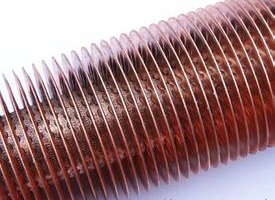Lord Fin Tube--Brazed spiral finned tubing
Brazed Spiral Finned Tubing
Brazed spiral finned tubing represents a pinnacle of heat transfer technology, combining exceptional thermal efficiency with structural integrity. This comprehensive guide explores the manufacturing process, technical specifications, performance characteristics, and applications of this advanced heat exchanger component.

Brazed spiral finned tubing in industrial heat exchanger application
Manufacturing Process of Brazed Spiral Finned Tubing
Step 1: Spiral Winding
The steel strip is wound perpendicular to the pipe axis in a precise spiral pattern around the outer surface of the base tube. The ends of the steel strip are securely welded to the steel pipe to maintain structural integrity during subsequent processing.
Step 2: Brazing Process
Using specialized brazing techniques, the strip and bare pipes are metallurgically bonded together. This process eliminates gaps between components and creates a permanent, high-strength connection that withstands thermal cycling and mechanical stress.
Technical Advantages of Brazed Spiral Finned Tubing
Performance Comparison: Brazed vs. Alternative Fin Technologies
| Parameter | Brazed Spiral Finned Tubing | Hot-Dip Galvanized Finned Tubing | Mechanically Attached Finned Tubing |
|---|---|---|---|
| Heat Transfer Efficiency | Excellent (95-98% of theoretical maximum) | Good (75-85% of theoretical maximum) | Variable (60-90% depending on contact pressure) |
| Thermal Resistance | Very Low (0.001-0.003 m²K/W) | Moderate (0.005-0.015 m²K/W) | Variable (0.002-0.020 m²K/W) |
| Corrosion Resistance | Material Dependent (Excellent with stainless steel) | Limited (Zinc coating vulnerable to acids/sulfides) | Material Dependent |
| Maximum Operating Temperature | Up to 850°C (depending on base materials) | Up to 350°C (zinc coating limitation) | Up to 600°C (depending on mechanical properties) |
| Service Life in Aggressive Environments | 15-25+ years | 5-10 years | 8-15 years |
Brazed Spiral Finned Tubing Technical Specifications & Performance
Standard Material Combinations
- Base Tube Materials: Carbon Steel, Stainless Steel (304, 316, 321), Copper, Cupronickel, Titanium
- Fin Materials: Carbon Steel, Stainless Steel, Aluminum, Copper
- Brazing Materials: Copper-based alloys, Silver-based alloys, Nickel-based alloys
Typical Fin Configurations
- Fin Height: 6-25 mm (0.25-1.0 inch)
- Fin Thickness: 0.8-2.0 mm (0.03-0.08 inch)
- Fin Pitch: 2.5-10 fins per inch (100-400 fins per meter)
- Tube Diameters: 12.7-50.8 mm (0.5-2.0 inches)
Brazed Spiral Finned Tubing Industrial Applications
Technical Note: Limitations of Hot-Dip Galvanized Alternatives
While hot-dip galvanized spiral finned tubes offer a cost-effective alternative, they present significant limitations:
- Zinc coating (typically 50-100μm thick) creates additional thermal resistance, reducing heat transfer efficiency by 15-25% compared to brazed fins
- Zinc has approximately 78% the thermal conductivity of steel, further impeding heat transfer
- Zinc is vulnerable to corrosion in acidic, alkaline, or sulfide-containing environments, making it unsuitable for air preheaters in flue gas applications
- The galvanizing process cannot ensure complete penetration into the tight spaces between fin and tube, leaving potential weak points
Brazed Spiral Finned Tubing Quality Assurance & Testing
Brazed spiral finned tubing undergoes rigorous quality control procedures to ensure performance and reliability:
- Visual Inspection: Examination of fin alignment, brazing quality, and surface condition
- Dimensional Verification: Precise measurement of fin height, pitch, and tube dimensions
- Non-Destructive Testing: Ultrasonic testing, eddy current testing, or radiographic inspection to verify bond integrity
- Pressure Testing: Hydrostatic or pneumatic testing to verify tube integrity
- Thermal Performance Testing: Laboratory testing to verify heat transfer characteristics
Brazed spiral finned tubing
Brazed spiral finned tubing represents the optimal solution for demanding heat transfer applications where maximum efficiency, reliability, and longevity are required. While the initial investment is higher than alternative technologies, the superior performance, extended service life, and reduced maintenance requirements provide significant long-term value in industrial applications.
For applications involving corrosive environments, high temperatures, or critical performance requirements, brazed spiral finned tubing remains the technology of choice among thermal engineering professionals.

